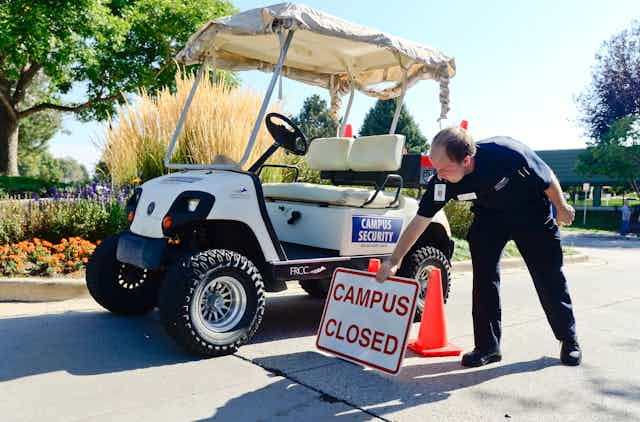When the state of California cut funding to the University of California system by US$619.3 million, or 19%, in the wake of the 2008-09 recession, the leaders of the UC system tried to spread the resulting economic pain to its employees in a fair way. More specifically, employees with bigger salaries took on larger cuts – 10% of their salaries at the top end – while those with smaller salaries faced smaller hits – 4% at the bottom end. The cuts also came with workload reductions, which were essentially furloughs.
In presenting the progressive furlough plan, the UC president at the time explained that it was all about shared sacrifice. This approach, along with hiring freezes and other measures, helped the UC system weather the crisis.
Today, in face of the COVID-19 pandemic, colleges and universities across the nation may be confronting financial challenges even greater than those the University of California faced a decade ago. By some estimates, up to 20% of schools may go out of business by the time the pandemic runs its course. Many more are expected to be badly crippled financially.
While the success of the UC’s progressive furlough strategy offers a model for how colleges and universities can shore up their finances, with a few exceptions, it’s not the route that many schools appear to be taking, based on a review of news articles reporting on the steps schools are taking.
Rather, the option being pursued by wealthy private schools like Washington University in St. Louis, less affluent public schools like Western Michigan University – where I work – and religiously affiliated institutions like Marquette University involves distinguishing two types of employees - the essential and the nonessential.
Needed vs. not needed
This two-pronged strategy starts by defining essential employees as those whose work needs to be done now. Essential employees include, for instance, those who are actively teaching classes as well as high-level administrators, and campus police to protect school property. This group continues with their daily duties – though, often doing so remotely – and they keep receiving full pay and benefits.
The nonessential group, which makes up a significant share of these schools’ workforces, isn’t so lucky.
With campuses shuttered and classes moved online, these employees – from the department assistants who help students with their schedules, to the custodians and groundskeepers who keep the campus clean – face reduced workloads with corresponding reductions in pay.
While this strategy may help schools weather the financial crisis, the UC system’s progressive furlough model shows that there’s another way - one that aligns with these institutions’ expressed commitments to social justice for their employees and their communities.
As a moral philosopher who examines the dynamics around making difficult decisions, I believe that progressive furloughs are a morally better choice.
Spreading the economic pain
Most obviously, when a school’s workforce is divided into essential and nonessential, the hardship and stress of reduced pay only hits some employees. In some cases, these pay cuts may be manageable. But in many others, they will be severe. In fact, at some schools, 30% of employees now find themselves on unpaid leave through the summer.
To make up for their lost wages, nonessential employees will need to draw on their vacation time and sick day allocations. In some cases, they may still be able to file for unemployment. To their credit, some schools have bolstered these leave balances with special COVID-19 leave time. But this additional leave time will only go so far.
Further, once this leave time has been exhausted, these employees are placed on unpaid leave, losing not just their paycheck, but sometimes also their regular health care insurance benefits. School leaders are sensitive to these risks and have been soliciting contributions for newly created relief funds for employees affected by the pandemic. But voluntary efforts like these can only do so much.
The case for help
Of course, some may wonder why schools should pay employees when there’s no work for them to do. But this thought assumes that these are ordinary times and that these institutions are ordinary employers.
However, the toll from the pandemic is unprecedented. And most colleges and universities – with their commitment to social justice – have accepted a leadership role in protecting the livelihood and well-being of their employees and contractors.
The University of California system again provides an example of how colleges and universities can keep their commitment. The progressive furlough plan at the University of California system provided exemptions to some of the lowest earners: graduate students (like me at the time) and other student workers.
Challenges remain
Though I see progressive furloughs as a more equitable way for higher education to address its financial challenges, saying that does not mean that doing it will be easy, or that furloughs alone will be enough.
It could be challenging to ensure that all employees have a say in how the furloughs are structured. Some groups will be able to do this through their unions, but accommodations will be needed for those who lack union representation.
While bringing in these employee representatives could complicate negotiations, all participants in these discussions would do well to ask themselves this ethical question: Would I rather accept a modest, temporary reduction in my pay, or see my “nonessential” colleague placed on unpaid leave?
There may also be a larger lesson here. Colleges and universities are not alone in facing financial challenges brought on by the pandemic. While progressively structured furloughs may not work for every part of the economy, the ideal they embody – the principle of shared sacrifice – surely applies beyond the walls of academia.
[You need to understand the coronavirus pandemic, and we can help. Read The Conversation’s newsletter.]

